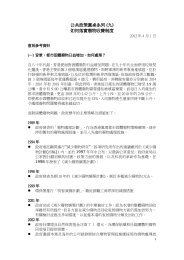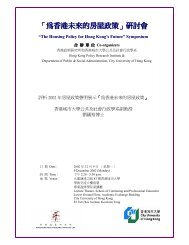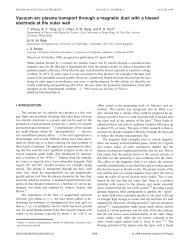Oxygen-vacancy and depth-dependent violet double-peak ...
Oxygen-vacancy and depth-dependent violet double-peak ...
Oxygen-vacancy and depth-dependent violet double-peak ...
Create successful ePaper yourself
Turn your PDF publications into a flip-book with our unique Google optimized e-Paper software.
<strong>Oxygen</strong>-<strong>vacancy</strong> <strong>and</strong> <strong>depth</strong>-<strong>dependent</strong> <strong>violet</strong> <strong>double</strong>-<strong>peak</strong> photoluminescence<br />
from ultrathin cuboid SnO2 nanocrystals<br />
L. Z. Liu, 1 X. L. Wu, 1,a) J. Q. Xu, 1 T. H. Li, 1,2 J. C. Shen, 1 <strong>and</strong> Paul K. Chu 3,a)<br />
1<br />
National Laboratory of Solid State Microstructures <strong>and</strong> Department of Physics, Nanjing University,<br />
Nanjing 210093, People’s Republic of China<br />
2<br />
College of Electronic Engineering, Guangxi Normal University, Guilin 541004, People’s Republic of China<br />
3<br />
Department of Physics <strong>and</strong> Materials Science, City University of Hong Kong, Tat Chee Avenue, Kowloon,<br />
Hong Kong, China<br />
(Received 11 December 2011; accepted 3 March 2012; published online 20 March 2012)<br />
A <strong>double</strong> <strong>peak</strong> in the <strong>violet</strong> region between 360 <strong>and</strong> 400 nm is observed from the<br />
photoluminescence spectra acquired from cuboid SnO2 nanocrystals <strong>and</strong> the energy separation<br />
between the two sub<strong>peak</strong>s increases with nanocrystal size. The phenomenon arises from b<strong>and</strong> edge<br />
recombination caused by different in-<strong>depth</strong> distributions of oxygen vacancies (OVs). Density<br />
functional theory calculations disclose that variations in the oxygen vacancies with <strong>depth</strong> introduce<br />
valence-b<strong>and</strong> <strong>peak</strong> splitting leading to the observed splitting <strong>and</strong> shift of the <strong>double</strong> <strong>peak</strong>. VC 2012<br />
American Institute of Physics. [http://dx.doi.org/10.1063/1.3696044]<br />
As an n-type wide b<strong>and</strong> gap semiconductor (Eg ¼ 3.6 eV<br />
at 300 K), tin oxide (SnO2) has many potential applications<br />
in biophysics, gas sensing, catalysis, <strong>and</strong> batteries. 1–5 However,<br />
despite a large exciton binding energy of 130 meV, development<br />
of optoelectronic devices encompassing bulk<br />
SnO2 materials has been hampered by its dipole forbidden<br />
nature. 6,7 Fortunately, changes in the symmetry of the nanostructures<br />
induced by surface states may allow direct gap<br />
transitions 8,9<br />
rendering quantum-confined photolumines-<br />
cence (PL) possible. 10,11 The surface of a metal oxide nanostructure<br />
plays a crucial role in the PL characteristics which<br />
can be modified by the addition of oxygen vacancies (OVs),<br />
especially nanostructures with small size. Although the PL<br />
<strong>peak</strong>s are typically attributed to radiative recombination in<br />
some defect states such as tin interstitials, dangling bonds, or<br />
OVs, rigorous confirmation has not been performed. 12,13<br />
Theoretical derivations disclose that the highest occupied<br />
orbitals are localized at the surface OVs, thus giving rise to<br />
many new energy states in the b<strong>and</strong> gap. 14 Hence, the optical<br />
properties are related to the complicated optical transition<br />
induced by OVs. It is well known that OVs exist at different<br />
<strong>depth</strong>s in metal oxides <strong>and</strong> so a better underst<strong>and</strong>ing of their<br />
role <strong>and</strong> effects is of scientific <strong>and</strong> practical interest. Cuboid<br />
nanocrystals (NCs) have a large surface-to-volume ratio <strong>and</strong><br />
so surface atoms <strong>and</strong> electronic states play a key role in the<br />
luminescence behavior. In this work, the effects of the different<br />
OV distributions with <strong>depth</strong> in cuboid SnO 2 NCs on the<br />
PL behavior are investigated. The <strong>double</strong> <strong>peak</strong> appears in the<br />
<strong>violet</strong> range <strong>and</strong> the separation between the two sub<strong>peak</strong>s<br />
increases with cuboid NC length. In addition to experimental<br />
investigation, theoretical derivation based on the density<br />
functional theory (DFT) is performed to elucidate the<br />
mechanism.<br />
SnO2 NC samples were prepared using a hydrothermal<br />
reaction involving SnCl4 5H2O <strong>and</strong> CO(NH2)2. In a typical<br />
process, 0.08 g of SnCl 4 5H 2O <strong>and</strong> 0.8 g of CO(NH 2) 2 were<br />
a) Authors to whom correspondence should be addressed. Electronic<br />
addresses: hkxlwu@nju.edu.cn <strong>and</strong> paul.chu@cityu.edu.hk.<br />
APPLIED PHYSICS LETTERS 100, 121903 (2012)<br />
added to a 40 ml cylindrical teflon-lined stainless steel autoclave<br />
containing 32 ml of deionized water, <strong>and</strong> 1.6 ml of HCl<br />
fume was introduced, followed by ultrasonic treatment <strong>and</strong><br />
heating to 90 C for 15 h. After the reaction, the autoclave<br />
was cooled to room temperature naturally. The white precipitates<br />
were centrifuged <strong>and</strong> rinsed thoroughly with water several<br />
times. The SnO2 NC colloidal suspensions were used in<br />
the experiments <strong>and</strong> the partial colloidal suspensions were<br />
oven-dried in air at 100 C for 5 h. The samples were characterized<br />
by high-resolution transmission electron microscopy<br />
(HR-TEM, JEOL-2100), Raman scattering, PL excitation,<br />
<strong>and</strong> x-ray photoelectron spectroscopy (XPS). 15,16 All the<br />
measurements were conducted at room temperature.<br />
The PL spectra acquired from the colloidal suspension<br />
containing SnO 2 NCs with different sizes excited by the<br />
280–310 nm lines of a Xe lamp are shown in Fig. 1(a). As<br />
the average NC size increases (that is, with increasing excitation<br />
wavelength from 280–310 nm), a <strong>double</strong> <strong>peak</strong> emerges<br />
from the PL spectrum. The high energy sub<strong>peak</strong> (S1) position<br />
[ 356 nm (3.48 eV)] does not vary, but the low energy<br />
sub<strong>peak</strong> (S 2) downshifts to 397 nm (3.12 eV) with<br />
FIG. 1. (Color online) (a) PL spectra of the ultrathin cuboid SnO2 NC suspension<br />
excited by the 280-310 nm lines of a Xe lamp. (b) PL spectra composed<br />
of tow sub<strong>peak</strong>s acquired from the suspension <strong>and</strong> dried powder<br />
excited by 310 nm.<br />
0003-6951/2012/100(12)/121903/4/$30.00 100, 121903-1<br />
VC 2012 American Institute of Physics
121903-2 Liu et al. Appl. Phys. Lett. 100, 121903 (2012)<br />
increasing NC size <strong>and</strong> meantime, the line-width increases<br />
as well. S1 is close to the b<strong>and</strong>gap energy of 3.65 eV (to be<br />
discussed in detail below), but S 2 has a lower energy. The<br />
observed PL may arise from b<strong>and</strong> edge recombination as a<br />
result of relaxation from the forbidden dipole. To explore the<br />
mechanism, the NC suspension was dried in air at 100 C for<br />
5 h before taking another PL spectrum [Fig. 1(b)]. The PL<br />
spectrum is obviously broadened <strong>and</strong> composed of two sub<strong>peak</strong>s<br />
(S 1 <strong>and</strong> S 2 marked by green <strong>and</strong> magenta dash lines<br />
based on Gaussian fittings). Comparison to the PL spectrum<br />
of the colloidal suspension discloses that the effects of water<br />
on the optical emission are minimal. Moreover, the position<br />
of S1 does not change, but S2 downshifts <strong>and</strong> the line-width<br />
increases. This implies that the PL mechanism of the suspension<br />
<strong>and</strong> dried sample is similar <strong>and</strong> the surface structure<br />
induced by water is not the main factor. Since OVs in metal<br />
oxides play an important role in the electronic <strong>and</strong> phonon<br />
properties, the <strong>double</strong> <strong>peak</strong> should be associated with OVs<br />
on the NC surface.<br />
The HR-TEM images acquired from the colloidal suspensions<br />
are depicted in Fig. 2(a). The NCs have a cuboid<br />
morphology with lateral dimensions of 4.0 nm, but the<br />
lengths are different (marked by dashed lines). The NCs<br />
have a rutile phase <strong>and</strong> grow mainly along the (001) direction.<br />
15 A lateral face of the ultrathin cuboid NC with the<br />
0.343 nm lattice fringe is the (110) crystalline plane. The<br />
selected-area electron diffraction (SAED) pattern in Fig. 1(b)<br />
shows three diffraction rings (from inner to outer) corresponding<br />
to the (110), (101), <strong>and</strong> (211) planes of rutile SnO 2.<br />
To confirm the existence of OVs, the Sn 3 d XPS spectrum<br />
obtained from the dried sample is displayed in Fig. 2(c). The<br />
binding energy of the Sn 3d 5/2 <strong>peak</strong> at 487.1 eV indicates<br />
that the valence of Sn is 3.62, 17 suggesting the cuboid NCs<br />
are nonstoichiometric with a large number of OVs in the<br />
near surface. The Gaussian fitted cuboid NC length distribu-<br />
FIG. 2. (Color online) (a) Typical HR-TEM image of the SnO2 NCs. (b)<br />
SAED pattern of the SnO2 NCs. (c) Sn 3d XPS spectrum of the SnO2 NCs.<br />
(d) Length distribution of the SnO 2 NCs with lateral width D of 4.0 nm.<br />
tion shown in Fig. 2(d) shows that the NC lengths have a<br />
widely distribution from 6.0–13.5 nm <strong>and</strong> should be responsible<br />
for the dependence on excitation wavelength [Fig. 1(a)]<br />
induced by the NC size change. For a fixed OV content,<br />
increase in the NC length corresponds to a larger average<br />
distribution <strong>depth</strong> of OVs in the near surface due to the<br />
smaller surface-to-volume ratio. This is similar to the effects<br />
induced by annealing. The results <strong>and</strong> subsequent analyses<br />
suggest that the change in the OV <strong>depth</strong> distribution induced<br />
by the NC size change gives rise to the observed PL<br />
characteristics.<br />
Since the b<strong>and</strong> gap of nanostructured materials can be<br />
different from that of the bulk counterparts, the ultra<strong>violet</strong>/<br />
visible absorption spectrum obtained from the NC suspension<br />
is presented in Fig. 3. The absorption coefficient a is<br />
expressed as aðh Þ/ðh EgÞ 1=2 =h , 18 <strong>and</strong> plots of<br />
½aðh ÞŠ 2 vs h can be derived from the absorption data with<br />
the intercept of the tangent (marked by red line) corresponding<br />
approximately to the b<strong>and</strong> gap energy of the direct b<strong>and</strong><br />
gap materials. As shown in Fig. 3, the average b<strong>and</strong> gap of<br />
the cuboid NCs is 3.65 eV which is slightly larger than that<br />
of bulk materials due to the quantum size effect. The two PL<br />
sub<strong>peak</strong>s have energies of 3.5 <strong>and</strong> 3.1 eV, which in the vicinity<br />
of the b<strong>and</strong> gap of the cuboid NC. This implies that the<br />
observed PL should be associated with b<strong>and</strong> edge recombination<br />
of the photo-excited carriers resulting from relaxation<br />
from the forbidden dipole due to the introduction of OVs.<br />
The Raman spectrum of the SnO2 NC sample is displayed in<br />
the inset of Fig. 3. Besides the E u longitudinal optical mode<br />
(f 1) at 355 cm 1 <strong>and</strong> A 1g mode (f 3) at 631 cm 1 which are<br />
related to the small size effect according to the Matossi force<br />
constant model, 19,20 an intense mode appears at 574 cm 1<br />
(f 2) from the in-plane OVs (Ref. 21), but other types of OVs<br />
cannot be detected. Therefore, the <strong>double</strong> <strong>peak</strong> PL is inferred<br />
to stem from b<strong>and</strong> edge recombination determined by the inplane<br />
OVs which have different <strong>depth</strong> distributions in the<br />
near surface of the NC.<br />
To theoretically elucidate the dependence of the PL<br />
<strong>peak</strong> on the OV <strong>depth</strong> distribution, a DFT study is conducted<br />
on several samples with different OV <strong>depth</strong> distributions.<br />
The calculation is based on the generalized gradient approximation<br />
of Perdew, Burke, <strong>and</strong> Ernzerholf using the CSATEP<br />
package with norm-conserving pseudopotential with default<br />
convergence tolerances of 1 10 5 eV for energy <strong>and</strong><br />
FIG. 3. (Color online) Ultra<strong>violet</strong>/visible absorption spectrum acquired<br />
from the SnO 2 NCs. The inset shows the corresponding Raman spectrum.
121903-3 Liu et al. Appl. Phys. Lett. 100, 121903 (2012)<br />
0.03 eV/A ˚ for maximum displacement. 22 The rutile SnO2<br />
(110) surface is modeled as a (1 1) supercell consisting of<br />
a six trilayer slab <strong>and</strong> vacuum with a thickness of five trilayers.<br />
The bottom two trilayers are fixed to mimic the bulk,<br />
<strong>and</strong> the in-plane oxygen atoms at different <strong>depth</strong>s are<br />
removed. The density of states (DOSs) with the in-plane OV<br />
<strong>depth</strong> distributions at d ¼ 0, 0.314, <strong>and</strong> 0.627 nm are calculated<br />
<strong>and</strong> shown in Fig. 4 <strong>and</strong> the result without OV is also<br />
presented for comparison. In the case of the less stable surface<br />
<strong>vacancy</strong> model, in which in-plane oxygen is absent<br />
from the stoichiometric surface, the highest occupied orbitals<br />
are significantly localized at the position of removed oxygen<br />
atom. Therefore, the DOSs at the valence-b<strong>and</strong> maximum<br />
(VBM) can be modified by surface in-plane OV positions.<br />
According to the DOSs in Fig. 4 (left), the transition between<br />
the conductance b<strong>and</strong> major <strong>peak</strong> near 3.56 eV (black arrow)<br />
<strong>and</strong> VBM at 0 eV corresponds to a 3.56 eV PL <strong>peak</strong>. Considering<br />
the under-estimation of the gap in the DFT calculation<br />
with the local density approximation (LDA) <strong>and</strong> generalized<br />
gradient approximation exchange-correlation function, 23,24<br />
this is in good agreement with our experimental PL results.<br />
Here, it is interesting to note that addition of OV causes splitting<br />
of the DOS <strong>peak</strong> at the VBM (Fig. 4, right), which corresponds<br />
to the splitting of the PL <strong>peak</strong> observed<br />
experimentally <strong>and</strong> modified b<strong>and</strong> gap. With increasing<br />
<strong>depth</strong>s of OVs, splitting increases <strong>and</strong> the trend is consistent<br />
with experimental results.<br />
It is known that both in-plane <strong>and</strong> bridging OVs may<br />
simultaneously exist in SnO 2 nanostructures. To reveal the<br />
different OV contributions, the DOSs of the SnO 2 nanostructure<br />
surfaces with different OV types are calculated <strong>and</strong> the<br />
corresponding results are presented in Fig. 5. Compared to<br />
the results without OV, the DOS (left) is significantly different<br />
in the presence of different OVs. The enlarged VBM<br />
regions with different kinds of OV situations are shown on<br />
the right side of Fig. 5. In the presence of in-plane OV, the<br />
DOS (green line) shows a clear <strong>double</strong>-<strong>peak</strong> structure,<br />
whereas the existence of a bridging OV effectively changes<br />
the DOS distribution into a single <strong>peak</strong> structure (red line).<br />
Considering the coexistence of in-plane <strong>and</strong> bridging OVs,<br />
FIG. 4. (Color online) Left: DOSs of the cuboid NC surfaces with OV distribution<br />
<strong>depth</strong>s at d ¼ 0, 0.314, <strong>and</strong> 0.627 nm <strong>and</strong> no <strong>vacancy</strong>. Right:<br />
Enlarged VBM region. Splitting of the VBM due to addition of OV can be<br />
clearly seen <strong>and</strong> it leads to splitting of the PL <strong>peak</strong> observed experimentally.<br />
FIG. 5. (Color online) Left: DOSs of the cuboid NC surfaces with different<br />
OV types <strong>and</strong> no <strong>vacancy</strong>. Right: Enlarged VBM region. Splitting of the<br />
VBM due to addition of in-plane OV can be clearly observed. The bridging<br />
OVs do not cause the observed <strong>violet</strong> <strong>double</strong>-<strong>peak</strong> PL.<br />
the combined action not only causes splitting of the DOS<br />
(blue line) <strong>peak</strong> at the VBM but also modifies the intensities.<br />
The theoretical results indicate that the in-plane OV is responsible<br />
for the splitting of the DOS <strong>peak</strong> at the VBM. The<br />
bridging OVs may co-exist in the samples, but they are not<br />
the origin of the observed <strong>violet</strong> <strong>double</strong>-<strong>peak</strong> PL.<br />
In summary, the PL spectra obtained from ultrathin<br />
cuboid SnO2 NCs show a <strong>double</strong> <strong>peak</strong> in the <strong>violet</strong> region <strong>and</strong><br />
the energy separation between the two sub<strong>peak</strong>s increases<br />
with NC size. It is related to changes in the in-plane OV <strong>depth</strong><br />
distribution in the near surface of the NC. DFT calculation<br />
discloses that splitting of DOS at the VBM increases with OV<br />
<strong>depth</strong> distribution, thereby leading to b<strong>and</strong> edge recombination.<br />
As a result, the PL <strong>peak</strong> splits <strong>and</strong> the two sub<strong>peak</strong>s shift<br />
oppositely, as verified by the experimental results.<br />
This work was jointly supported by Grants (Nos.<br />
2011CB922102 <strong>and</strong> 60976063) from the National Natural<br />
Science Foundation <strong>and</strong> Basic Research Programs of China.<br />
Partial support was also from PAPD, Postdoctoral Science<br />
Foundations of China <strong>and</strong> Jiangsu Province (Nos.<br />
2011M500889 <strong>and</strong> 1102001B), <strong>and</strong> Hong Kong Research<br />
Grants Council (RGC) General Research Fund (GRF) No.<br />
CityU 112510.<br />
1 S. Brovelli, A. Chiodini, A. Lauria, F. Meinardi, <strong>and</strong> A. Paleari, Phys.<br />
Rev. B 73, 073406 (2006).<br />
2 C. Killic <strong>and</strong> A. Zunger, Phys. Rev. Lett. 88, 095501 (2002).<br />
3 H. T. Chen, S. J. Xiong, X. L. Wu, J. Zhu, J. C. Shen, <strong>and</strong> P. K. Chu, Nano<br />
Lett. 9, 1926 (2009).<br />
4 Y. Idota, T. Kubota, A. Matsufuji, Y. Maekawa, <strong>and</strong> T. Miyasaka, Science<br />
276, 1395 (1997).<br />
5 R. Asahi, T. Morijawa, T. Ohwaki, K. Aoki, <strong>and</strong> Y. Taga, Science 293,<br />
269 (2001).<br />
6 G. Blattner, C. Klingshrin, <strong>and</strong> R. Helbig, Solid State Commun. 33, 341<br />
(1980).<br />
7 F. Arlinghaus, J. Phys. Chem. Solids 35, 931 (1974).<br />
8 A. Kar, M. A. Stroscio, M. Dutta, J. Kumari, <strong>and</strong> M. Meyyappan, Appl.<br />
Phys. Lett. 94, 101905 (2009).<br />
9 R. Chen, G. Z. Xing, J. Gao, Z. Zhang, T. Wu, <strong>and</strong> H. D. Sun, Appl. Phys.<br />
Lett. 95, 061908 (2009).<br />
10 E. J. H. Lee, C. Ribeiro, T. R. Giraldi, E. Longo, <strong>and</strong> E. R. Leite, Appl.<br />
Phys. Lett. 84, 1745 (2004).<br />
11 X. X. Xu, J. Zhuang, <strong>and</strong> X. Wang, J. Am. Chem. Soc. 130, 12527 (2008).
121903-4 Liu et al. Appl. Phys. Lett. 100, 121903 (2012)<br />
12 E. M. Wong <strong>and</strong> P. C. Searson, Appl. Phys. Lett. 74, 2939 (1999).<br />
13 T. W. Kim, D. U. Lee, <strong>and</strong> Y. S. Yoon, J. Appl. Phys. 88, 3759 (2000).<br />
14 M. A. Mäki-Jaskari <strong>and</strong> T. T. Rantal, Phys. Rev. B 65, 245428 (2002).<br />
15 L. Z. Liu, X. X. Li, X. L. Wu, X. T. Chen, <strong>and</strong> P. K. Chu, Appl. Phys.<br />
Lett. 98, 133102 (2011).<br />
16 L. Z. Liu, J. Wang, X. L. Wu, T. H. Li, <strong>and</strong> P. K. Chu, Opt. Lett. 35, 4026<br />
(2010).<br />
17 C. H. Liang, Y. Shimizu, T. Sasaki, <strong>and</strong> N. Koshizaki, J. Phys. Chem. B<br />
107, 9220 (2003).<br />
18 G. Mills, Z. G. Li, <strong>and</strong> D. Meisel, J. Phys. Chem. 92, 822 (1988).<br />
19 Y. J. Chen, L. Nie, X. Y. Xue, Y. G. Wang, <strong>and</strong> T. H. Wang, Appl. Phys.<br />
Lett. 88, 083105 (2006).<br />
20 J. Zou, C. Y. Xu, X. M. Liu, C. S. Wang, C. Y. Wang, Y. Hu, <strong>and</strong> Y. T.<br />
Qian, J. Appl. Phys. 75, 1835 (1994).<br />
21 L. Z. Liu, X. L. Wu, F. Gao, J. C. Shen, T. H. Li, <strong>and</strong> P. K. Chu, Solid<br />
State Commun. 151, 811 (2011).<br />
22 B. G. Pfrommer, M. Cote, S. G. Louie, <strong>and</strong> M. L. Cohen, J. Comput. Phys.<br />
131, 233 (1997).<br />
23 M. A. Maki-Jaskari <strong>and</strong> T. T. Rantala, Phy. Rev. B 64, 075407 (2001).<br />
24 G. Cicero, A. Catellani, <strong>and</strong> G. Galli, Phy. Rev. Lett. 93, 016102 (2004).

















